Affiliate Disclosure: As an Amazon Associate I earn from qualifying purchases.
Power over Ethernet, more commonly referred to as PoE, is a term that you will often see branded on various different networking products, but what exactly is PoE and how does it work?
Power over Ethernet is a process in which electrical power along with data is transferred over a single Ethernet cable. This allows the single cable to provide both a data connection and power to different PoE enabled devices, such as a security camera, wireless access point, or VoIP telephone.
In this article, we’ll look at what Power over Ethernet is, how it works, how power can be delivered to devices in different ways, and answer some frequently asked questions.
What is Power over Ethernet?
Power over Ethernet is a method of being able to power a device with an Ethernet cable, whilst still providing the device with the network connectivity that it needs to perform the function it was made to do.
Unlike non-PoE devices that require both an Ethernet cable and an external power supply, PoE only requires a single cable.
Devices that are capable of functioning on PoE can be considered power sourcing equipment (PSE), powered devices (PDs), or at times both. The device responsible for transmitting power is the PSE, while the device that is being powered is the PD.
PSEs can come in various forms, including a PoE switch, PoE hub, or PoE injector. What you use as the PSE will be determined by your existing equipment.
For example, a PoE injector is intended for use with a non-PoE switch as a way of delivering Power over Ethernet.
A few examples of PDs are wireless access points, IP security cameras, and VoIP telephones; all of which are commonly found on a home network.
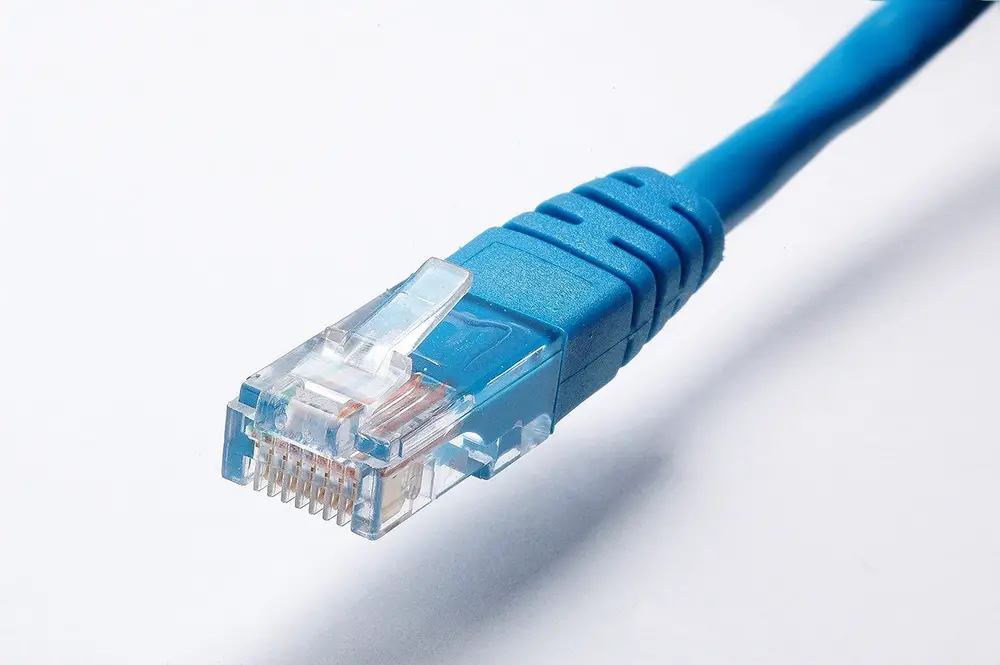
How Does Power Over Ethernet Work?
To get a better understanding of how PoE actually works, we first need to get familiar with how the network cable itself works.
Within a standard Ethernet cable, you will find 8 individual wires that are twisted together to form 4 pairs.
Traditionally, when only 100 MB networks were around, only two of these pairs were used for data transfer. The remaining two pairs were available for delivering power.
Nowadays, most networks will support up to 1000 MB speeds.
The difference between 100 MB and 1000 MB is substantial, resulting in greater requirements to function.
Therefore, all four pairs of wires must be used which doesn’t leave any leftover for the DC current.
Power over Ethernet works by injecting a voltage of around 48 volts into the cable. This low power output keeps it safe whilst also delivering enough power to the device to allow it to work efficiently.
You may also like: What Is the Difference Between Cat5, Cat5e and Cat6 Cable?
Power over Ethernet Standards
Like with many other protocols, there are standards to which Power over Ethernet must meet in order to function. The two most common are 802.3af and 802.3at.
The difference between these two standards is the amount of power than a device can use.
802.3af is used for devices that only consume up to 15.4 watts of power, whereas 802.3at offers a bit more flexibility in that it can support up to 30 watts of power.
When planning your home network, keep this in mind as you will need to make sure the PoE network switch you use complies with a standard that will work with the PoE devices you are looking to connect.
Two of the most common PoE devices used within a home: network security cameras and wireless access points will often have greater power requirements, so if you are looking to connect these devices, you will need to make sure the PSE device you are using supports the 802.3at standard.
| Standard | Type | Maximum Power Per Device |
| 802.3af (PoE) | Type 1 | 15.4W |
| 802.3at (PoE+) | Type 2 | 30.8W |
| 802.3bt (UPoE) | Type 3 | 60W |
| 802.3bt | Type 4 | 95W |
How Can Power Over Ethernet Be Delivered?
Although a PoE enabled network switch is the most common way of delivering Power over Ethernet, it is not the only method.
Even with a regular non-PoE switch, you can deliver PoE with the help from a few separate devices.
PoE Switch
A PoE switch looks just like a regular switch, however, it is the ability to provide Power over Ethernet straight from its ports; no other equipment required.
Some PoE switches, particularly those you are more likely to use within a home network, do not have PoE enabled on every port. For example, you may find on an 8 port switch that only 4 of the ports can deliver PoE.
Just something to keep in mind when connecting both your PoE and non-PoE devices to the switch.
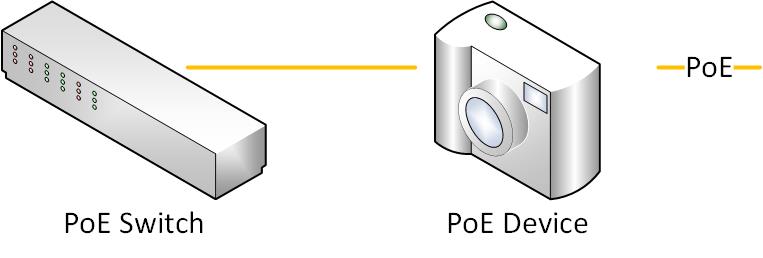
PoE Injector
A PoE injector is used to send power to the signals sent from a non-PoE network switch to PoE devices.
Most switches these days will come with some PoE capability, however, if you have an older, more basic network switch, a PoE injector is a useful way of still being able to deliver both power and network connectivity to your device over the single cable.
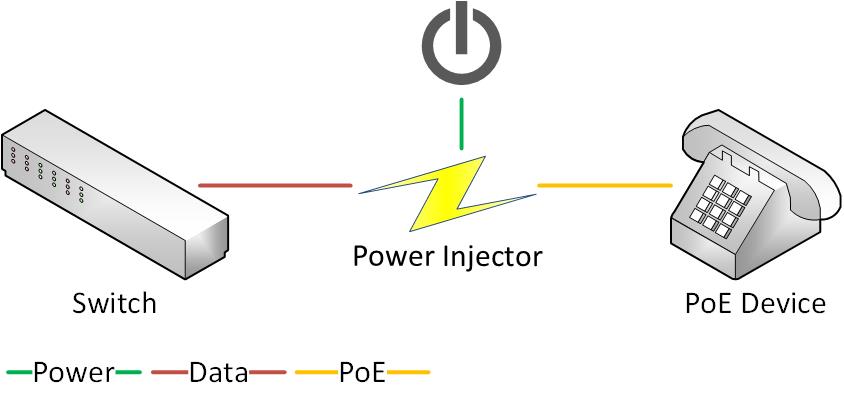
PoE Hub
Simply put, a PoE hub is a stack of multiple PoE injectors.
As an example, a 4 port PoE hub will have 4 ports for receiving data from the switch and 4 ports for delivering PoE to your devices.
For PoE to work, each PoE port will require a data connection with the corresponding port on the hub.
A hub will not forward data to other ports, so if you are receiving data into port 1 of the hub, the device you are looking to deliver PoE to must plug into the corresponding PoE port 1 to function.
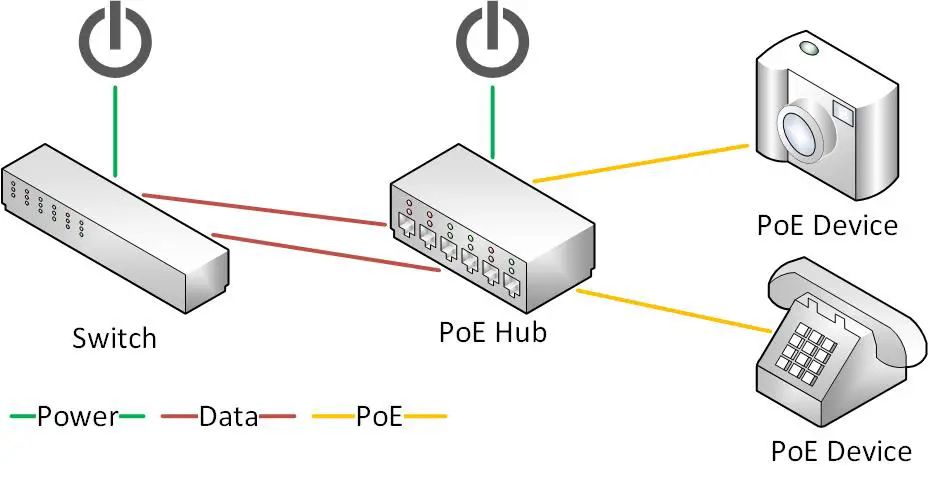
PoE Splitter
A PoE splitter works by splitting the power from the data and feeding it separately into the device.
Splitters are more commonly used on older devices or those with lower power requirements.
The downside to using a splitter is that two network cables will need to be fed from the splitter into the device, but this is still easier than having to run a separate power supply to give the device power.
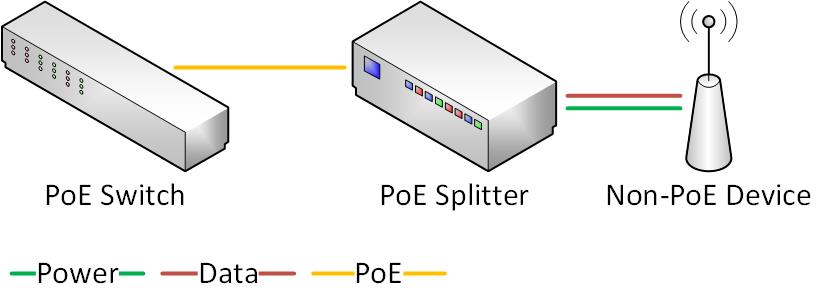
PoE Extender
PoE extenders must be used when looking to extend the distance of the cabling beyond the limit for your average twisted-pair Ethernet cable.
These are often required in networks that span a large area such as hotels or shopping centers.

Frequently Asked Questions
1. Does Power over Ethernet Require Special Cables?
Power over Ethernet doesn’t require any special cabling; Cat5e, Cat6 and RJ45 style connectors can be used to connect both PoE and non-PoE devices to a network.
That being said, it is recommended to opt for a full copper cable that has an AWG of 23 or 24, with 23 being recommended for Cat6 cables.
The cheaper, less durable CCA (Copper Coated Aluminium) cables have a higher DC resistance and therefore generate more heat whilst transferring less power.
CCA cables are also more fragile and the inner wires can break much more easily.
My advice is to stay away from the cheap cables and invest in ones from a reputable brand that are durable and of good quality.
2. What Is the Maximum Distance of Power over Ethernet?
Power over Ethernet can travel a maximum distance of 100m from the switch to the device, regardless of where the power is being injected.
What limits you to 100m is not the power, but the Ethernet cabling standards.
A PoE ethernet extender can be used, however, to extend this distance up to 4000ft or 1219m.
It is unlikely you will need to extend PoE over 100m within your home, but many corporate environments with large offices will often require this extension.
Related article: How Far Can You Run an Ethernet Cable?
3. What Devices Use Power over Ethernet?
Here are a few examples of commonly found PoE devices. This list will inevitably grow as more people begin to adopt PoE and more manufacturers continue to develop their products.
- Wireless access points
- Routers
- VoIP phones
- Security cameras
- Lighting systems
- Digital signage
- Smart devices
4. Can you mix PoE and non-PoE devices on a network?
Yes, you can use a mix of PoE and non-PoE devices on a network. Just bear in mind that the non-PoE devices will require a separate power supply, so this will need to be considered when planning your home network.
5. How much power can PoE devices supply?
PoE devices can supply a maximum of 15.4 watts per port, whereas PoE+ devices are capable of supplying up to 30 watts per port. Do bear in mind that some power is always lost over the length of the cable, with more power being lost the longer the cable runs.
The minimum guaranteed power that is available to the device is 12.95 watts per port for PoE and 25.5 watts per port for PoE+.
6. What is PoE+?
PoE+ is simply a reference to the 802.3at standard we described earlier in this article.
The main difference between 802.3af (PoE) and 802.3at (PoE+) is that PoE+ can deliver almost twice as much power to a device over a single Ethernet cable compared to PoE.
PoE+ can deliver power to both PoE and PoE+ devices, but PoE power sourcing equipment will only support PoE powered devices.
PoE+ PDs have greater power requirements that PoE PSEs simply cannot provide.
7. What is UPoE?
Universal Power over Ethernet (UPoE) is a newer standard that extends the PoE+ standard to double the power per port up to 60 watts.
Conclusion
Power over Ethernet is a method of being able to deliver both power and network connectivity to a device over a single Ethernet cable.
It works by injecting power into the cable; the amount of power injected depends on the PoE standard used.
Power can be injected into the cable through a number of ways, including a dedicated PoE switch, a separate PoE power injector, or a PoE hub.
If you are looking to connect a few PoE devices to your network, perhaps an IP security camera or a wireless access point, my recommendation would be to invest in a small PoE switch.
A typical 8 port PoE switch will be able to supply PoE to 4 of these ports, which will be sufficient for most people looking to connect just a few PoE devices.
I hope you found this article helpful and now have a better understanding of what Power over Ethernet is, how it works, and how you can incorporate it into your own home network.
